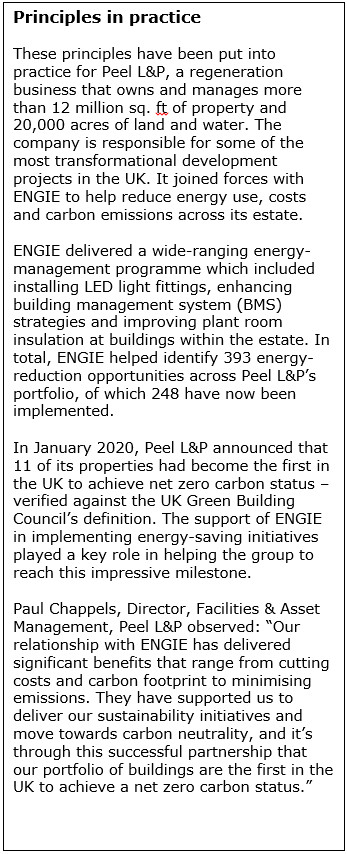A combined effort is required to create and sustain carbon-neutral buildings

Making the transition to net zero operations is an important priority for every business, says Kirti Rudra of ENGIE
The UK government has set a target to reach net zero greenhouse gas emissions by 2050, which will result in more legislation, as well as incentives, to ensure businesses play their part.
For businesses, achieving net zero requires a coordinated approach from every area of the organisation. One of the most significant sources of carbon emissions for any business are its buildings and facilities. Buildings are responsible for nearly 40% of global greenhouse gas emissions, and with many organisations committed to achieving carbon neutrality, they are a critical solution to driving carbon-reduction targets.
A good starting point for any carbon-reduction programme is an initial assessment to identify the origins of all carbon emissions associated with buildings, including indirect emissions from electricity, heat, steam and cooling purchased by the business. Once you understand where building-related carbon emissions come from, you can begin to tackle them in a systematic way.
Energy savings have a big impact
Any carbon-reduction programme will rely heavily on reducing energy usage. Consumption of energy generated from non-renewable sources is one of the biggest causes of carbon emissions for most businesses.
The first step is to assess how much energy is being consumed, when and where it is being consumed, and where efficiencies can be made. Accurately targeting energy efficiency requires a clear view of all energy data, and sophisticated energy-management software can help to analyse this data and identify opportunities for improvements.
In many cases, energy use can be reduced simply by tweaking processes, altering temperature and control settings, modifying equipment set-points and adjusting timings. Smart building technology can play an important role in ensuring carbon-reduction measures are sustained for the long-term, by automating the control of energy-consuming assets to ensure they are continuously operated at optimum efficiency.
Convert to low-carbon assets
Once you have optimised efficiency using existing building assets, you may need to convert some assets into more energy-efficient alternatives, or even invest in new equipment. With the right advice and guidance, you can ensure that any investments in low-carbon equipment are more than repaid over the lifetime of those assets.
Consider renewable sourcing

After making the most efficient use of the energy consumed in your buildings, the next step is to consider where that energy comes from. Sourcing electricity from renewable generators is an effective way to reduce your carbon emissions. Corporate power purchase agreements enable you to secure a direct supply agreement with a specific renewable generator, so you can demonstrate exactly where your energy is coming from.
Another option is self-generation. Installing wind or solar generation assets on site provides a direct source of renewable power, reduces your reliance on grid energy and offers an opportunity to earn revenue by exporting any surplus to the grid. Installing batteries on site to store excess electricity and provide back-up power can further reduce your reliance on energy from the grid.
Carbon offsetting
Ideally, carbon reduction should be achieved by adding new sources of renewable power to the electricity network, whether on-site or linked directly to your premises. However, once carbon emissions have been cut to the lowest possible level for the organisation, it may be necessary to sign up to carbon-compensation schemes to offset any residual emissions associated with the buildings.
Sustaining zero-carbon status
It’s likely that achieving net zero buildings will require a combination of all of these measures. It’s essential to achieve the correct balance of options for the organisation. For buildings to remain truly carbon-neutral, facilities management systems and processes will need to be reviewed continually to ensure they remain effective. It’s crucial to ensure that all measures work in harmony and avoid conflicting actions in different parts of your buildings. Taking a holistic view of all activities in a building is therefore the key to success.
Kirti Rudra is Solutions Development Director at ENGIE







